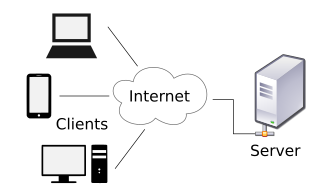
The client–server model is a distributed application structure that partitions tasks or workloads between the providers of a resource or service, called servers, and service requesters, called clients. Often clients and servers communicate over a computer network on separate hardware, but both client and server may reside in the same system. A server host runs one or more server programs, which share their resources with clients. A client usually does not share any of its resources, but it requests content or service from a server. Clients, therefore, initiate communication sessions with servers, which await incoming requests. Examples of computer applications that use the client–server model are email, network printing, and the World Wide Web.
Internetworking is the practice of interconnecting multiple computer networks, such that any pair of hosts in the connected networks can exchange messages irrespective of their hardware-level networking technology. The resulting system of interconnected networks is called an internetwork, or simply an internet.
The Internet protocol suite, commonly known as TCP/IP, is a framework for organizing the set of communication protocols used in the Internet and similar computer networks according to functional criteria. The foundational protocols in the suite are the Transmission Control Protocol (TCP), the User Datagram Protocol (UDP), and the Internet Protocol (IP). Early versions of this networking model were known as the Department of Defense (DoD) model because the research and development were funded by the United States Department of Defense through DARPA.

The Open Systems Interconnection (OSI) model is a reference model from the International Organization for Standardization (ISO) that "provides a common basis for the coordination of standards development for the purpose of systems interconnection." In the OSI reference model, the communications between systems are split into seven different abstraction layers: Physical, Data Link, Network, Transport, Session, Presentation, and Application.

Peer-to-peer (P2P) computing or networking is a distributed application architecture that partitions tasks or workloads between peers. Peers are equally privileged, equipotent participants in the network, forming a peer-to-peer network of nodes. In addition, a personal area network (PAN) is also in nature a type of decentralized peer-to-peer network typically between two devices.
DECnet is a suite of network protocols created by Digital Equipment Corporation. Originally released in 1975 in order to connect two PDP-11 minicomputers, it evolved into one of the first peer-to-peer network architectures, thus transforming DEC into a networking powerhouse in the 1980s. Initially built with three layers, it later (1982) evolved into a seven-layer OSI-compliant networking protocol.

In computer networking, the transport layer is a conceptual division of methods in the layered architecture of protocols in the network stack in the Internet protocol suite and the OSI model. The protocols of this layer provide end-to-end communication services for applications. It provides services such as connection-oriented communication, reliability, flow control, and multiplexing.
An application layer is an abstraction layer that specifies the shared communication protocols and interface methods used by hosts in a communications network. An application layer abstraction is specified in both the Internet Protocol Suite (TCP/IP) and the OSI model. Although both models use the same term for their respective highest-level layer, the detailed definitions and purposes are different.

KNX is an open standard for commercial and residential building automation. KNX devices can manage lighting, blinds and shutters, HVAC, security systems, energy management, audio video, domestic appliances, displays, remote control, etc. KNX evolved from three earlier standards; the European Home Systems Protocol (EHS), BatiBUS, and the European Installation Bus.

A distributed hash table (DHT) is a distributed system that provides a lookup service similar to a hash table. Key–value pairs are stored in a DHT, and any participating node can efficiently retrieve the value associated with a given key. The main advantage of a DHT is that nodes can be added or removed with minimum work around re-distributing keys. Keys are unique identifiers which map to particular values, which in turn can be anything from addresses, to documents, to arbitrary data. Responsibility for maintaining the mapping from keys to values is distributed among the nodes, in such a way that a change in the set of participants causes a minimal amount of disruption. This allows a DHT to scale to extremely large numbers of nodes and to handle continual node arrivals, departures, and failures.
An anonymous P2P communication system is a peer-to-peer distributed application in which the nodes, which are used to share resources, or participants are anonymous or pseudonymous. Anonymity of participants is usually achieved by special routing overlay networks that hide the physical location of each node from other participants.
In computer networking, a network service is an application running at the network application layer and above, that provides data storage, manipulation, presentation, communication or other capability which is often implemented using a client–server or peer-to-peer architecture based on application layer network protocols.
An overlay network is a computer network that is layered on top of another network. The concept of overlay networking is distinct from the traditional model of OSI layered networks, and almost always assumes that the underlay network is an IP network of some kind.

A computer network is a set of computers sharing resources located on or provided by network nodes. Computers use common communication protocols over digital interconnections to communicate with each other. These interconnections are made up of telecommunication network technologies based on physically wired, optical, and wireless radio-frequency methods that may be arranged in a variety of network topologies.
Peer-to-peer SIP (P2P-SIP) is an implementation of a distributed voice over Internet Protocol (VoIP) or instant messaging communications application using a peer-to-peer (P2P) architecture in which session control between communication end points is facilitated with the Session Initiation Protocol (SIP).
Scalable Source Routing (SSR) is a routing protocol for unstructured networks such as mobile ad hoc networks, mesh networks, or sensor networks. It combines source routing with routing along a virtual ring, and is based on the idea of "pushing Chord into the underlay".
A communication protocol is a system of rules that allows two or more entities of a communications system to transmit information via any variation of a physical quantity. The protocol defines the rules, syntax, semantics, and synchronization of communication and possible error recovery methods. Protocols may be implemented by hardware, software, or a combination of both.
Security service is a service, provided by a layer of communicating open systems, which ensures adequate security of the systems or of data transfers as defined by ITU-T X.800 Recommendation.
X.800 and ISO 7498-2 are technically aligned. This model is widely recognized

P2PSP is a communication protocol of the application layer for streaming multimedia content on the Internet, that is, where users play the stream in sync. This can be used to build a variety of live broadcasting services ranging from small meetings to large systems IPTV. Unlike traditional CS (Client-Server) and CDN based video streaming, P2P contributes its upstream bandwidth to the system. Therefore, in general, P2P systems are more scalable architectures based on the model client-server. This protocol helps in reducing the bandwidth usage of the source of the broadcast by using the upload bandwidth of the peers connected to the source.







